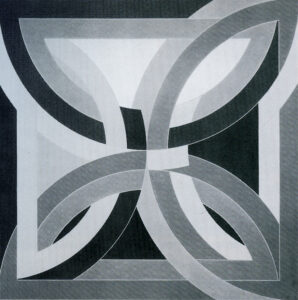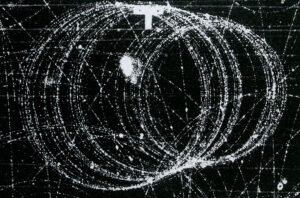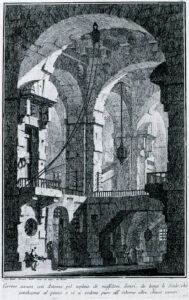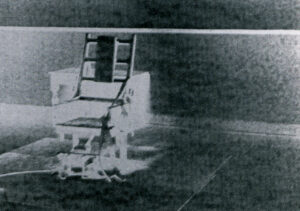1997
by John Zinsser
Von Lintel Editions
When David Row arrived in New York in 1975, painting had recently been declared dead, and nobody was calling the paramedics. Since World War II, new movements had been coming along in neat packages—abstract expressionism, pop, color field, minimalism, each one opened, explored and put back in the box. Clement Greenberg declared that painting had reached its final reductive state:flatness. Brice Ma rden had played the endgame monochrome trump card in his oil-and-wax panels—all surface handling and finesse; Robert Ryman had forced viewers to confront paintings as physical objects, and Carl Andre and Donald Judd had created works of minimalist sculpture that were an open critique of the very legitimacy of painting as a medium.

fig. 1, Frank Stella, Abra Variation 1, 1969
Row didn’t believe those obituary notices. Along with other painters of his generation—Ross Bleckner, Philip Taaffe and Jonathan Lasker—he felt that the task was not to bury modern painting but to reinvigorate it and reinvent it. His work invites viewers into a dialogue about what a painting is and about the many ways a painting can be read. He knew that there were—and still are—many important questions to be asked and answered.
Born in 1949 in rural Maine and educated at Yale, Row had an epiphany that set him on the trail to becoming an artist in 1969 at the Metropolitan Museum of Art. Henry Geldzahler’s exhibit, New York Painting and Sculpture: 1940 – 1970 so intoxicated him that he decided to go to graduate school at Yale and study painting in earnest. But, once there, he found the narrow academic cli mate stifling, and he left to spend a year in India to join his parents.They had been living there for years, his father working as a city planner. That was a second awakening. He found himself drawn to certain non-Western ideas, particularly the Indian concept of infinity, which he felt he could incorporate in his work, expanding the formalist definition of abstraction both visually and metaphysically.
Returning to graduate school in 1973, Row began to explore issues that have remained a constant in his work ever since. He defined his work as “post-cubist,” meaning that geometric forms don’t necessarily rely on being extrapolated from finite observable space. He also began to develop the large, blocky rectangles and curves that were to become his signature. Recalling that period recently in his studio on lower Broadway overlooking the rooftops of Soho, Row, a boyish-looking man with an intense focus in his eyes, told me that those signature rectangles and curves came from an impulse to “simplify” and “clarify” the many issues that he felt pressing upon him. He took mischievous pleas ure, he says, in “playing games” with the authoritarian language of geometric abstraction. That search for a new language can be traced as a free-associational hopscotch from Bauhaus and de Stijl through Mondrian and the New York school as practiced by Al Held, who briefly had been his advisor at the Yale Graduate School.
He also began to turn to other art media for inspiration. He particularly loved the process-driven “look” of printmaking, its seriality and rigid architectonic restrictions. He adapted these qualities to his painting program, weighing printmaking’s inherent feeling of mechanical coldness and distance against the hands-on sensuality and lushness of oil as a medium.

fig. 2, David Row, Photosilkscreen image
Row also began what became his signature practice of working with a set of elliptically-shaped templates— curved hard-edged cardboard guides from which he could trace shapes, then flip them over and create mirror symmetries. The templates became a tool for exploring ideas about structure. Row used them in an exploratory manner, whereby the shapes began to suggest
their own logic and to influence Row’s iconography of their own accord—a process not unlike Frank Stella’s use of a protractor in his famous Protractor Series of the late 196os [fig. 1]. With Row, the templates could remain the same—a given—while the work transformed itself around them. Internal scale could remain constant while external scale shifted from work to work.Thus a sense of wholeness was reinforced through Row’s entire corpus, in contrast to the individual nature of specific pieces.
Concurrently, Row created a set of silk-screen images based on his own photographs of natural phenomena. The field-oriented subjects—expanses of rocks, sand, grass, sky—stood as a visual mimesis to known motifs of abstraction [fig. 2] He physically pushed paint through these screens, exploiting the photomechanical dot-screen quality that resulted.
In the case of Row’s non-photographic sources, content was more history- and culture-specific. From the world of science, he seized upon J.D. Watson and F.H. Crick’s 1953 model of DNA [fig. 3], with its twisting and ladder-like form. From the world of art, he re-examined Brancusi’s 1918 Endless Column sculpture. Row’s reliance on these forms to build a visual vocabulary derived from his desire to “break open” the language of geometry. Yet his stated means remained simple and pragmatic. His dictum, he says, was:”Make a shape. Flip it over. Flip it around again.” He remembers being especially taken with “acompositional” and “continuous” structures. One paradox open for investigation was the academic preconception that a painting should inherently “do something,” a geometric totem defined by its sharply zigzagging silhouette.

fig. 3, J. Watson, F Crick, model of DNA molecule, 1953
Two questions arose. First, could a structural “whole” be synthesized completely through an assembly of fragments? And second, could traditional associations of symmetry—from biological configurations through the history of hierarchical architectural orders—be visually subverted? Both issues arose from Row’s desire to question the viewer’s expectations. He rightly believed that these geometric schema carried with them a sense of anticipation, a prospect of balance or order that could be gently tweaked, subverted or denied outright. This precariousness came down to a simple matter of action, a need for his work to “go somewhere.”
In Helix, a 1986 two-panel work (page 23), a segmented helical spiral is represented in profile as a series of curvilinear S-shaped segments that rise majestically through a two-color ground. Where the top and bottom panels adjoin, making a strong horizon-like division, a symmetry is enforced: the color scheme reverses itself from black-on-gray to gray-on-black. Though the helix motif is graphic, the paint handling is physical. The pitch-of-night black makes action-specific striations as it drags across the brooding gray. By scraping the surface in a violent gestural manner, Row is drawing attention to the paint surface itself as a corporeal thing.
What ongoing concerns of Row’s are being introduced here? One is the use of a modular geometric component to activate an internally-divided rectangle. Another is the use of the helix motif as only one segment of a potentially infinite progression. Row shows an interest not just in symmetry, but in “mirroring.” The top and bottom of the painting are bilaterally divided, and at that juncture comes a reversal of positive and negative space. The central iconic form is continuous, universal, expansive. Yet, as shown here, it is only a fragment of itself, albeit an elegantly-ordered, self-sustaining one. Row is suggesting that a part may represent a universal whole.
In Vert De Grece,1987 (page 29), the internal configurations have grown more complex, architectonic and overlapping. Two primary structures collide: a rising, zigzagging ladder or stair-like form, and two concentric sets of elliptical rings. Each form is but an integer of a larger scheme. Row intentionally presents shapes as cropped. He thereby acknowledges a compositional convention that comes not from the history of painting, but from photography. This truncated sectioning makes for a violent intervention upon what would otherwise be perceived as neo-Platonic serenity. The neat, internal segmentation found in the work of Row’s minimalist progenitors, Frank Stella and Robert Mangold, has been jettisoned in favor of a more discursive view. Rather than celebrate form in its perfect wholeness, Row offers a glimpse of infinity. He is after a fleeting moment in a universe where order and disorder vie with each other as equal polarities.
In Laguna,1988 (page 35), Row’s ellipses have become vertically oriented, forming an outwardly-propelling black-and-white spiral. The effect on the viewer is disorientation, vertigo. What is black becomes white; night becomes day. Positive space slips an integer and becomes negative space. The paint handling is equally nervous: the surface just won’t stand still.
In 1990 he broke his paintings out of their conventional rectilinear format. He introduced what he terms a “divided triptych” structure. Here, three self-contained rectangles abut. Each piece contains a fragmentary image which, when viewed with its reciprocal units, suggests a larger whole. Issues of fracture vs. continuance are brought into new tensions. Like the stone plinths of a Roman architectural ruin, the lone parts suggest a much larger sense of weight and structure. Each panel offers a clue to a bigger, more complex edifice.

fig. 4, Constantin Brancusi, Endless Column, 1918
In Untitled,1990 (page 47), Row’s ellipse moves through three adjoining panels, suggesting the rectilinear confinement of a complex expanding curve as found in classical Greek “golden section” diagrams. The divisions heighten the sensation of ad hoc motion. Issues of unity, disunity and velocity are reinforced by Row’s paint handling:the surface is by turns slathered, blotted, smeared and scraped.The paint has an authority all its own that exerts its own physical nature, expressing a gestural attitude antithetical to the rigidity of its geometric confines.
With his triptych series Row found that his ideas became more concise. The parts are “provisional,” posing an open question meant to provoke a viewer’s “desire for completion.” Also, the forms themselves became “infinite” and the segmentation doesn’t intrude on that condition. Here, Row’s work is counterpoised against Stella’s shaped canvas series from the 1960s – in particular, Stella’s Copper Series, first shown at New York’s Castelli Gallery in 1962. In those paintings, Stella’s internal stripes were configured to conform to the irregularly-shaped outer stretcher bars.
The triptych Split Infinitive, also 1990 (page 59), by its very title reflected Row’s growing interest in linguistic theory and generative grammar. By 1990, he had come to rely on semiotic analysis as a means to decode the signifiers of abstract painting, along his with fellow New York painters David Reed, Stephen Ellis and
Lydia Dona. Geometry, color, brushstroke and physical support structure are just some of recognized elements that make up this “syntax” of abstraction.These painters used this type of analysis to explore the ways in which a painting could be broken down into its component parts. Row’s title seems to ask the question: If painting is a language, what are its parts of speech? And how can those parts be disassembled and recombined to create new symmetries, juxtapositions or fractures? Moreover, if this was possible, could viewers arrive at new synthesized viewing experiences?
By 1991, with triptych works such as Deep Focus (page 61), Row introduced an extreme shift in palette. The color sensibility in his earlier paintings was marked by its spare elegance and graphic understatedness. His colors might even have been characterized, God forbid, as tasteful. Now he swings the chromatic pendulum in
the opposite direction. Fluorescent reds, high-key lime greens and shocking pinks begin to make up his primary palette, though always mediated and weighted down by their pairings with solid black bars and curves. His earlier whites, blues, grays, earth browns and reds seemed elegiac. Oddly enough, these new shocker hues continue to reiterate that mood. Only the sphere of reference has changed. Suddenly Row is drawing on Pepto Bismol, 7-Eleven Slurpee cups, the language of the American roadside vernacular, to revisit his earlier themes.
With his triptych series, Row brought his structural interest in segmentation into concrete form. In his subsequent untitled series of 1992/93, with works like Ground Zero (page 79), the directional vector of his examination is reversed: the paintings embraced the question of wholeness, balance and containment. They consist of two equal sized joined canvases, each with a free standing iconic “0” or zero, centered on a white ground.The zero form is the natural extrapolation and extension of the sectional ellipse as it had been represented in earlier works. Here the zeros stand tall and proud in all their semiotic glory, rendered in flat graphic colors like black, chrome green or dump-truck red. Suddenly the “0” is stating its undivided and intact fullness. It is open to verbal, rebus-like readings: all, nothing, double or nothing, or even just an exclamation “Oh!”

fig 5, electron in a magnetic field
By a strange coincidence, the double zero motif would soon show up as a central iconographic motif in the work of the psycho-sexual multimedia sculptor Matthew Barney and in the Dr. Seuss-inspired abstractions of Carl Ostendarp.
In Flatland, 1994 (page 93), two vertical zeros stand in their now iconic wholeness, on two abutting panels. The structure is symmetrical, mirroring. The overall feel is like that of an architectural blueprint: outer contour suggests volume; form is seen as if in plan or elevation. But rather than have this linearity suggest stasis, Row opts for a sense of urgency and agitation. A viewer witnesses a history of traces left behind as the shapes have been positioned and repositioned, rotated between frontal and oblique perspectives. The effect is like an image from an electron microscope: the presence of matter is suggested only by the recordings of where it has been—not where it actually is [fig. 5]. Row is moving toward the simultaneous representation of things there and not there.

fig 6. GB Piranesi, The Prisons from “Carceri d’invenzione”, 1850
In Ouisque,1995 (page 87), ellipses now whirl and tumble through alternating strips of darkened and lighted space. The feeling of velocity is on the increase. The internal circular curves push with more urgency against the boundaries determined by the stretcher bars. In the painting’s darker sections, the space has deeply striated and variegated light, making for a chiaroscuro effect. A viewer is immediately drawn into what reads as an internal Piranesian architectural space [fig. 6]. Yet the quality of the light is photographic. It seems to translate in clipped flashes, like a coldly ticking strobe.
By 1996, with Tryst (page 111), Row has moved his forms into an interior space of an even deeper black. Again, the sense of disjunctive segmentation has grown severe. The means of representation grows even more photographic, as Row drags streaks of white through large areas of black, pushing a reading of contained light.
More recently, in works like Wind Cools Itself, 1996 (page 108/109), Row seems to be suggesting that retinal cohesiveness can be attained through a densely packed turbulent agglomeration of otherwise discordant elements. The painting stands as a virtual inventory of the motifs that Row has explored in his work up to this point. It is both encyclopedic and hermetically self- referential. Severe overlappings of calligraphic shapes are contained in a strongly rectilinear architectural format. Paint is handled aggressively, mixed wet-into-wet, scratched and scumbled in places, added to and erased at will. The overall effect of blackness, with its graphic associations of printing and photomechanical processes, gives the composition its visual weight and ballast. With blackness, too, comes gravity, a sense of the omnipresence of death as passed down to us from Warhol’s “Electric Chair” series [fig. 7]. The central calligraphic line element, not free-hand but still fabricated with the help of a template, is antic and playful, though rendered grainy and strangely vestigial. The line suggests a certain hopelessness, a comment on the fleetingness of finite form. What was there is gone by thetime you manage to see it.

fig. 7, Andy Warhol, Electric Chair, 1971
By now Row is showing the canonical language of formalism in a fully eroded condition. His most recent paintings appear frozen in mid-action, like some strange natural phenomenon hung out for prolonged inspection. Modernism has been broken down into multivalent parts—geometric formalism, photographic convention, linguistic analysis—which now become the building blocks for new pluralistic beginnings. Row’s work has loosed its formalist moorings and is traveling of its own volition and velocity, constantly relocating itself in relation to the historical continuum. Yet at heart, his paintings remain about a sustained belief in possibility.